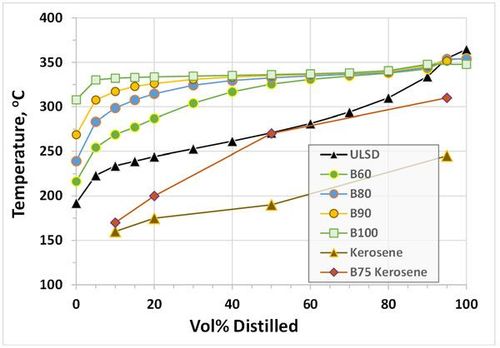Overcoming Limitations of Higher Biomass-Based Diesel Blends

Figure 1: D86 distillation curves for ULSD and its biodiesel blends. SOURCE: NREL
December 19, 2024
BY Robert McCormick
Commercial haulers, transit bus agencies and other heavy-duty applications can use United States-produced biodiesel blended with conventional diesel to reduce their environmental impact. But the amount of biodiesel used in fuel blends has been limited to up to 20% (B20), and there is not much information available on the properties of higher-level blends.
A large body of data supports B20 use, and the required properties of blends up to B20 are described in ASTM International’s standard D7467. But the use of higher blends, such as 50% (B50), 80% (B80) or even 100% biodiesel (B100), has not been widely explored in controlled engineering studies. The National Renewable Energy Laboratory, sponsored by the U.S. Department of Energy Vehicle Technologies Office, conducted research to identify barriers preventing the use of blends over 20% along with strategies to overcome them.
Gauging Higher Blend Performance
Biodiesel is an oxygenate made from fats, oils and greases. Renewable diesel is made from the same feedstocks as biodiesel but processed into a hydrocarbon that is chemically more like petroleum diesel. The use of biodiesel and renewable diesel is forecast to reduce transportation-related greenhouse gas emissions from 40% to 86% compared to petroleum diesel, depending on the feedstock used. Biodiesel blends with renewable diesel are 100% renewable.
Advertisement
The National Renewable Energy Laboratory investigated the performance of 20%, 40%, 60%, 80% and in some cases, 90% blends of biodiesel into both renewable diesel and petroleum diesel. The research paper, “Properties That Potentially Limit High-Level Blends of Biomass-Based Diesel Fuel,” in the journal Energy & Fuels, describes the results. The research addresses a major data gap about biodiesel blends, as it looks at high-level blends as well as blends with renewable diesel and petroleum diesel.
The results showed that the most significant difference in fuel properties for biodiesel versus petroleum diesel or renewable diesel is boiling point or distillation curve. Conventional diesel fuel and renewable diesel boil between 200 and 350 degrees Celsius (390 to 660 degrees Fahrenheit). The lower-boiling-point components in the fuel evaporate and ignite at lower temperatures, releasing heat and increasing temperature so that the higher-boiling components can also evaporate—a critical step in combustion. But biodiesel has a much narrower boiling range of 300 to 350 degrees C and boils at the high end of the diesel range. This means that as the blend level is increased, there are fewer lower-boiling components, requiring higher temperatures to begin evaporating the fuel. Biodiesel’s high and narrow distillation curve can make fuel evaporation more difficult to achieve for high-level blends (over 50%) and B100.
The high boiling point of biodiesel can make engine cold starting more difficult. Additionally, if the fuel sprayed into the engine does not fully evaporate, the unevaporated fuel can accumulate in the engine lube oil, leading to less effective lubrication. Perhaps the most important problem caused by the high and narrow boiling point of B100 and high-level blends is that, in certain cases, it can cause the diesel oxidation catalyst (DOC) to fail to light off. In many diesel engine emission control systems, supplemental fuel is injected into the exhaust to be oxidized over the DOC, increasing the exhaust temperature for regeneration of the downstream diesel particle filter. A recent study of high-level blends found that B50 and higher blends were not being converted over the DOC at temperatures below about 350 C, likely because most of the fuel was not evaporating and simply passed through the catalyst as aerosol droplets. As a result, the particle filter did not achieve adequate temperature to burn off the accumulated soot.
Mitigating the Issues
An approach to mitigating the cold starting, cloud point, lube oil dilution and DOC light-off issues for high-level blends is to use a No. 1 diesel or kerosene as the hydrocarbon blending component. Fuel blenders commonly use this approach to lower the cloud point of wintertime diesel, including biodiesel blends. Because No.1 diesel/kerosene has a larger number of lower-boiling components than conventional diesel (it boils between approximately 150 and 300 C), it produces a biodiesel blend that boils across a wider range of temperatures.
Advertisement
Another approach that vehicle owners have used successfully is retrofitting the engine with a heated fuel system, like the Optimus Vector System, that starts the engine on petroleum diesel and switches to B100 after both the B100 and engine are warmed up. Heated fuel systems work for B100 as well as high-level blends. This approach addresses cold starting, cloud point and lube oil dilution, but may not address DOC light-off.
For the DOC light-off issue with B100 and very high-level blends where kerosene blending may not be effective, it is possible that a B100-specific engine calibration will be required. Calibration is part of the programming of the computer that governs operation of the engine. A B100-specific calibration would change engine operating parameters, such as injection timing and exhaust gas recirculation, to heat the exhaust to over 350 C before commanding fuel injection for DOC light-off and particle filter regeneration.
Significant future research is needed to address the challenges of high-level biodiesel blends, particularly regarding how they impact diesel engine emission control systems. The aforementioned NREL paper is a research road map for addressing these challenges.
Author: Robert McCormick
Senior Research Fellow
Fuels and Combustion Science
National Renewable Energy Laboratory
robert.mccormick@nrel.gov
Upcoming Events





